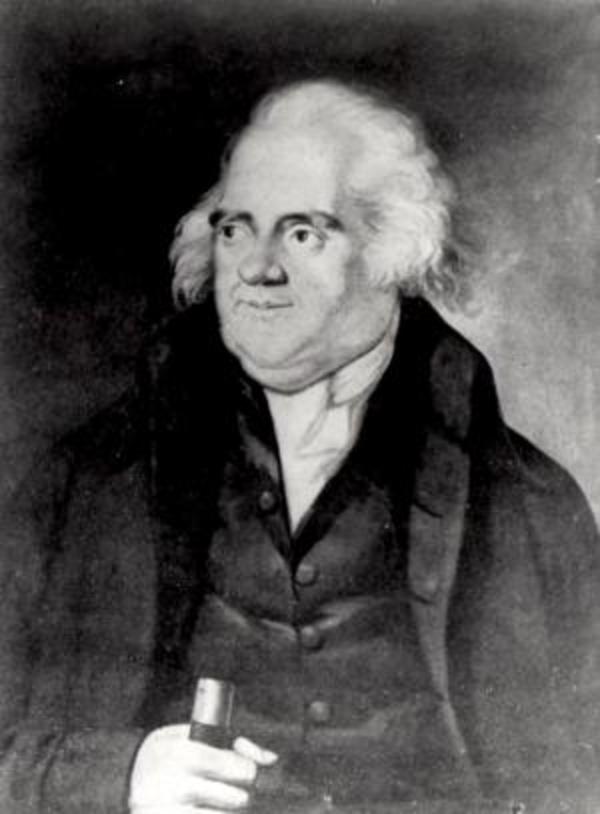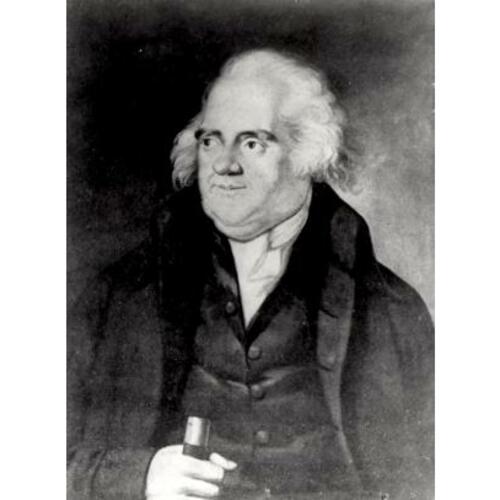
Source: Link
WILLCOCKS, WILLIAM, colonizer, merchant, judge, and office holder; b. January 1735/36, probably in Cork (Republic of Ireland), son of Charles Willcocks and Margaret Russell; m. c. 1760 Phoebe Jackson of Birr (County Offaly), and they had eight children; d. 7 Jan. 1813 in York (Toronto), Upper Canada.
William Willcocks spent his childhood with his first cousin, Peter Russell, on one occasion infecting him with lice at their school in Cork. After a seven-year apprenticeship with a Cork wine merchant and two years in Dublin engaged in successful litigation concerning an inheritance, he married about 1760 and began business as a commission merchant in Cork. Although at first he did well he was forced to stop payment in 1778 and thereafter he was in financial difficulties. In 1782 the loss of his two ships reduced him to bankruptcy from which he was finally discharged three years later. His election as sheriff of Cork in 1765 made him eligible for election as mayor, but this prize eluded him. By 1792 Willcocks was an unsuccessful merchant with unfulfilled municipal ambitions; thus he was easily persuaded to leave his family and follow Russell to Upper Canada.
Even before Willcocks’s arrival in Niagara (Niagara-on-the-Lake) on 24 Nov. 1792, Russell had procured for him and his son Charles a prestigious front lot in Toronto and 200 acres each in its neighbourhood. On 31 Dec. 1792 Willcocks and some associates were granted Norwich (Whitby and East Whitby) Township; Willcocks received 1,000 acres and each immigrant he settled there would get 200 acres. In January he left for Ireland and Wales to recruit settlers. His return was delayed by the outbreak of war with France, and by his election as mayor of Cork. After serving his year as mayor, in November 1794 he advertised land in Norwich, now Whitby, at prices from one to five guineas per 100 acres plus an annual rent. He sailed from Cork with 33 settlers on 10 May 1795, arriving in New York City on 15 July. Here everything went wrong – all his settlers deserted him, and he finally reached Kingston that October in an open boat, having abandoned at Oswego, N.Y., the goods for his proposed shop in York. While in Albany he again advertised land in Whitby “on moderate terms.”
Townships had been granted to accelerate settlement and to permit like-minded people to settle together; all grants were to be free except for government fees. Willcocks’s advertisements were “in manifest violation of the principles and conditions,” and on 25 May 1796 Whitby was taken from him by Lieutenant Governor Simcoe. Meanwhile Willcocks’s second group of Irish settlers had been captured at sea by the French. After Simcoe’s departure in July 1796 Russell, now administrator of Upper Canada, persuaded the Executive Council on 4 October to reserve Whitby to Willcocks for two more years, since he had been unaware he could not sell the land and had tried to bring settlers. Willcocks’s claims in Whitby were finally rescinded on 28 June 1797 because the French war made it unlikely that he could fulfil the conditions of the grant. The war also postponed the arrival of his family; it was not until 1801 that his wife, three daughters, and his son and daughter-in-law were all in Canada.
By the turn of the century Willcocks was established in York as a shopkeeper, magistrate, and first postmaster, resigning the last position in 1801. In January 1800 he had been appointed a judge of the Home District court – the only judge not a barrister – and judge of the Home District Surrogate Court. He had bought 15,000 acres in Norwich (North and South Norwich) Township, Oxford County, in 1799, but his land speculation proved disastrous; by 1803, when his second daughter, Phoebe, married William Warren Baldwin*, everything Willcocks had was under execution. Although not as radical as Joseph Willcocks, his second cousin once removed, he supported judge Robert Thorpe*’s political activities in 1806–7. In his old age he lived with the Baldwins, but spent much time at his property at Millbrook (Markham) involved in “useless schemes at Mill building,” according to his son-in-law. His debts were paid by selling land, and his property, like Peter Russell’s, eventually passed to the Baldwin family.
Willcocks’s Upper Canadian career owed more to Peter Russell’s influence than to his own ability; it demonstrates the power and limitation of 18th-century nepotism.
AO, ms 75. MTL, Robert Baldwin papers, sect.ii; W. W. Baldwin papers, sect.[i]–ii; Elizabeth Russell papers; Peter Russell papers. PAC, MG 23, HII, 7 (photocopies); RG 1, El, 46–48; E3, 19. PRO, C042/316–22. Corr. of Hon. Peter Russell (Cruikshank and Hunter). Corr. of Lieut. Governor Simcoe (Cruikshank). C. B. Gibson, The history of the county and city of Cork (2v., London, 1861), 2. E. A. Cruikshank, “An experiment in colonization in Upper Canada,” OH, 25 (1929): 32–77. G. C. Patterson, “Land settlement in Upper Canada, 1783–1840,” AO Report, 1920.
Cite This Article
Edith G. Firth, “WILLCOCKS, WILLIAM,” in Dictionary of Canadian Biography, vol. 5, University of Toronto/Université Laval, 2003–, accessed January 21, 2025, https://www.biographi.ca/en/bio/willcocks_william_5E.html.
The citation above shows the format for footnotes and endnotes according to the Chicago manual of style (16th edition). Information to be used in other citation formats:
| Permalink: | https://www.biographi.ca/en/bio/willcocks_william_5E.html |
| Author of Article: | Edith G. Firth |
| Title of Article: | WILLCOCKS, WILLIAM |
| Publication Name: | Dictionary of Canadian Biography, vol. 5 |
| Publisher: | University of Toronto/Université Laval |
| Year of revision: | 1983 |
| Access Date: | January 21, 2025 |



